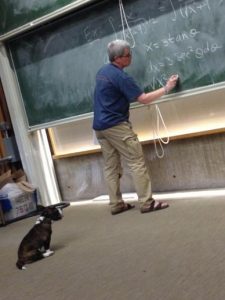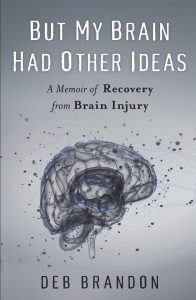Transformations: From Brain Injury Survivor to Writer
 It didn’t even occur to me write about it. It wasn’t as if it was an important part of the story. In fact, it was practically irrelevant. Yes, I had thought of suicide, but I didn’t have it in me, as I’d told the neuropsychologist who was evaluating me after my brain surgeries.
It didn’t even occur to me write about it. It wasn’t as if it was an important part of the story. In fact, it was practically irrelevant. Yes, I had thought of suicide, but I didn’t have it in me, as I’d told the neuropsychologist who was evaluating me after my brain surgeries.
I have cavernous angiomas, clusters of malformed blood vessels in my brain, and two of them had bled. The only way to prevent further bleeds was to surgically remove them.
After the surgeries, I spent a week in inpatient rehab. Upon arrival, the neuropsychologist began by asking me about my occupation and reading habits. I only realized this wasn’t idle chit-chat when she asked whether I’d thought about suicide.
I wasn’t sure how to respond. I wanted to be honest, but I didn’t want to raise unnecessary alarms. I just wanted to get better, and I was certain that the fleeting suicidal thoughts were irrelevant.
“It was at home, before the surgeries, when I was feeling terrible,” I explained. “I wasn’t really thinking of suicide, just about what pills I would use.” I shrugged. “It wasn’t a big deal. I don’t have it in me.”
She nodded and moved on to the next question. Clearly she agreed with me—it wasn’t important.
The evening before I was to be discharged from inpatient rehab, I was diagnosed with a CSF (cerebral spinal fluid) leak from the site of the second surgery. Instead of going home, I underwent another surgery, my third in less than two weeks.
 When I finally returned home, I felt lost and confused. Reclaiming my place in the world seemed daunting, impossible even.
When I finally returned home, I felt lost and confused. Reclaiming my place in the world seemed daunting, impossible even.
Everything felt off, my body, my brain, me, and everything around me. I had no idea how to go about adjusting to this new world, this new life. I had no idea where to turn for guidance. No one understood, and I couldn’t find what I needed in books or the internet.
I found plenty of information from outsiders’ perspectives—medical personnel and caregivers. I did find stories from the inside, by brain injury survivors, but they focused on crises and immediate trauma. A few addressed early recovery. But I needed stories from the inside about learning to live with brain injury.
An idea emerged from somewhere within the haze in my mind: I’d write of my own journey. I would follow my nose and record my progress, hoping for the best. It occurred to me that my account might help other survivors on similar paths to recovery. Perhaps it would also help caregivers to better understand us.
As I wrote and healed, I realized that my work was more important than I had originally thought, and I wanted to reach a broader audience. To do so effectively, I needed to improve as a writer.
I found a gifted teacher—she transformed me from a lackluster journal writer to an author of a book (But My Brain Had Other Ideas) that I am proud of.
I came to love writing, even when it was hard going.
The more I wrote, the more I wanted to write. A day without writing felt empty. I only took days off when I had no choice—during severe “bad brain days,” when I was incapacitated by exhaustion, exacerbated deficits, and excruciating headaches.
Writing my story forced me to revisit memories I’d buried deep in the recesses of my mind. Describing some of the hospital scenes was challenging. It was incredibly hard to write about telling my kids that surgery might not fix everything, that I might die or return as a vegetable.
But writing about the suicide was much tougher.
I wrote about grief, hopelessness, and depression, but not about suicide.
 Almost two years had passed since the surgeries when I began writing about my time in inpatient rehab. The scene with the neuropsychologist appeared on the page. And I still told myself that it wasn’t important, that I didn’t have it in me.
Almost two years had passed since the surgeries when I began writing about my time in inpatient rehab. The scene with the neuropsychologist appeared on the page. And I still told myself that it wasn’t important, that I didn’t have it in me.
But I felt a tiny wisp of a doubt. To maintain my integrity as a memoir writer, I had to investigate. I pushed myself to explore and found there was more to it. I had to admit that contemplating suicide wasn’t a one-time thing. I had to admit that my most recent bout was serious enough that I didn’t tell my therapist, afraid that she’d stop me.
The writing broke through my hidden dam of denial. Details flooded in, and with them, the recognition that these were no mere thoughts “that weren’t a big deal.” I had been suicidal. I did “have it in me.”
I realized that I could become suicidal again, a truth that shook my very foundation.
That same truth gave me the tools I needed to keep myself away from the edge of the abyss in the future.
I wrote, and healed, and in the process, underwent a profound transformation. My awareness increased, and I became more in tune with myself, both physically and psychologically. I began to recognize my brain injury symptoms for what they were. That, in turn, allowed me to address those symptoms and gain better insight into managing them.
The honesty and hard writing that memoir demanded of me caused me to grow more into myself as a person. I became a more authentic version of myself, more comfortable in my own skin.
Yes, writing is rough at times, and writing the stories we don’t want to tell ourselves is especially difficult.
But I am literally living proof of its importance: I am alive, and still writing.
—
Deborah Brandon, PhD has been a professor in the Mathematical Sciences Department at Carnegie Mellon University since 1991. She has participated nationally and internationally in dragon boating. She is a mother, a writer, and a respected textile artist, as well as a brain injury survivor.
Her essays have appeared in several publications, including the Weave A Real Peace newsletter, where she has a regular column; Dragon Boat World International, HandEye Magazine, Logan Magazine, SIAM Journal of Mathematical Analysis, and Journal of Integral Equations and Applications. Her books include Birth and Rebirth: Textile Techniques from Around the World. Brandon is an active blogger and regularly participates in social media platforms, including Facebook, where she discusses brain injury and its impact.
 When Deb Brandon discovered that cavernous angiomas―tangles of malformed blood vessels in her brain―were behind the terrifying symptoms she’d been experiencing, she underwent one brain surgery. And then another. And then another. And that was just the beginning.
When Deb Brandon discovered that cavernous angiomas―tangles of malformed blood vessels in her brain―were behind the terrifying symptoms she’d been experiencing, she underwent one brain surgery. And then another. And then another. And that was just the beginning.
The book also includes an introduction by Connie Lee, founder and president of the Angioma Alliance. Unlike other memoirs that focus on injury crisis and acute recovery, But My Brain Had Other Ideasfollows Brandon’s story all the way through to long-term recovery, revealing without sugarcoating or sentimentality Brandon’s struggles―and ultimate triumph.
Category: On Writing

























